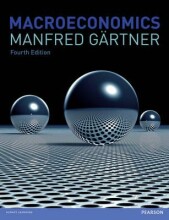Summary: Final Exam
- This + 400k other summaries
- A unique study and practice tool
- Never study anything twice again
- Get the grades you hope for
- 100% sure, 100% understanding
Read the summary and the most important questions on final exam
-
13 quesitons
This is a preview. There are 14 more flashcards available for chapter 13
Show more cards here -
Suppose consumption (C) is $40,000 when income is $45,000, and the marginal propensity to save (MPS) is 0.20. An increase in income causes C to rise to $46,000. What is the new income?
A. $52,500 -
If a $100 billion increase in investment spending creates $100 billion of new income in the first roundof the multiplier process and $60 billion in the second round, the multiplier in the economy is
D) 2.5. -
If consumption is $25,000 when income is $21,000, and consumption increases to $25,900 when income increases to $22,000, the Marginal Propensity to Save is
a. 0.1 -
If taxes depend on income, then the size of the government expenditure multiplier__ it would be iftaxes were a constant.
a. is smaller than -
in contrast to the United Kingdom, the U.S. government has opted for an injection of fiscal spendinginto its economy. If the U.S.’ MPC is 0.8, the net income tax rate is 0.2, the marginal propensity toimport is 0.04, and the government increases spending by $60 billion, then we would expect the U.S.GDP to increase by:
a) $150 billion. -
If an economy is heading towards a recession and if the authorities want to minimize the drop inreal GDP, they should
Decrease taxes and increase money supply -
Changes in which of the following will affect the size of the multiplier?
I. Marginal propensity to import.
II.Marginal propensity to save. -
In the short run, if the central bank decreases interest rates, then consumption and investment will ______, aggregate ______ will shift ______, and short-run equilibrium output will _______, and potential output is ________.
A) Increase; demand; right; increase; unchanged -
If national income is $1,500 billion and the level of AE is $1,375 billion, then we can say that:
A) There will be an accumulation of inventories, the prices of goods and services will fall, and output will rise.
B) There will be an accumulation of inventories, the prices of goods and services will rise, and output will fall.
C) There will be a reduction in inventories, the prices of goods and services will fall, and output will fall.
D) There will be a reduction in inventories, the prices of goods and services will rise, and output will rise.
E) None of the answers is correct. -
If consumption (C) is $30,000 when income is $22,000, and C increases to $32,000 and MPS is 0.2, then the new income is
a. $24,500
- Higher grades + faster learning
- Never study anything twice
- 100% sure, 100% understanding
































